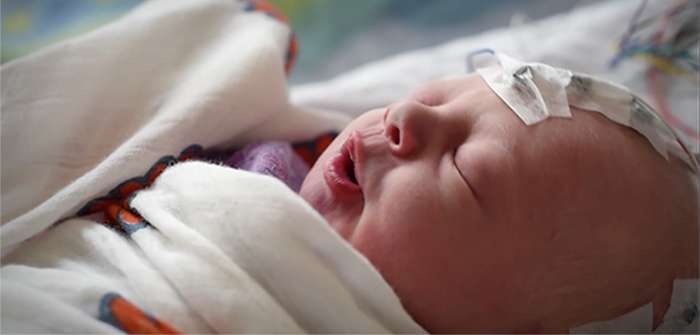A new non-invasive brain scanning technique allows clinicians to measure pain in infants from EEG readings in order to minimize discomfort during pediatric procedures. Credit: Department of Paediatrics, Medical Science Division, University of Oxford
(Medical Xpress)—A team of researchers affiliated with several institutions in the U.K. has conducted several trials that involved trying to detect pain in infants using EEG readings to measure brain response to painful events. In their paper published in the journal Science Translational Medicine, the group describes the trials they undertook with babies at hospitals in the U.K., what they learned, and what they plan to do next.
Recognizing pain in newborns, or even children before they learn to talk, is as much an art as a science—doctors, nurses and parents look for face scrunching, crying, kicking and other obvious signs of distress. Unfortunately, such signs can also mean the infant is hungry, in need of cuddling or was simply upset about something for a moment. In this new effort, the researchers have conducted a series of trials to gain a better understanding of when infants are truly in pain.
The trials consisted of affixing EEG monitors to the heads of babies undergoing activities such as blood tests (which required puncturing the skin with a lance), light touching, gentle poking and hearing a sudden noise. The pilot trial involved 18 infants who all faced lancing of the foot for a blood draw. That trial found that many of the babies experienced a sudden spike in neural activity after being poked with the lance. The team then conducted more trials where more babies were subjected to a wide variety of experiences including a blood draw. As part of the trial, some of the babies had a pain-relieving gel applied to the skin before a procedure. The team also compared EEG readings with grimacing and crying to see if there were any correlations.
Senior author Rebecca Slater discusses some of the challenges associated with diagnosing and treating pain in infants, and how a new brain scan method could help minimize pain for babies during necessary medical procedures. Credit: University of Oxford
The researchers report that they recorded neural spikes in many but not most of the babies after lancing—10 out of 28 showed no neural changes at all. They also found that while there were some apparent correlations between neural spiking and grimacing or squinting, there was not enough to make any definite conclusions. They also found some degree of reduction in neural spiking in infants that had the pain-relieving gel. The researchers plan to continue their trials over the course of the next three years with the goal of learning how to determine if an infant is in pain, and if they are, if analgesics work to reduce it, and which work the best at particular dosages.
Animation explaining how babies feel pain, and how researchers are working to develop improved methods to measure pain in infants. Credit: Charlotte Moultrie
More information: Caroline Hartley et al. Nociceptive brain activity as a measure of analgesic efficacy in infants, Science Translational Medicine (2017). DOI: 10.1126/scitranslmed.aah6122
Abstract
Pain in infants is undertreated and poorly understood, representing a major clinical problem. In part, this is due to our inability to objectively measure pain in nonverbal populations. We present and validate an electroencephalography-based measure of infant nociceptive brain activity that is evoked by acute noxious stimulation and is sensitive to analgesic modulation. This measure should be valuable both for mechanistic investigations and for testing analgesic efficacy in the infant population.
Journal information: Science Translational Medicine
© 2017 Medical Xpress




















